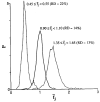Temporal fluctuations in regional myocardial flows
- PMID: 2928084
- PMCID: PMC3655777
- DOI: 10.1007/BF00584480
Temporal fluctuations in regional myocardial flows
Abstract
Considerable spatial heterogeneity has been observed in regional myocardial blood flow in isolated hearts and in both anesthetized and conscious animals. In order to study how local blood flow varies with time, the data obtained by King et al. (1985) from ten awake, healthy baboons were analyzed to estimate the role of temporal fluctuations. Four to six distributions of regional flows were estimated at intervals of 4 min to 27 h, using 15 mu diameter microspheres and dividing each heart into 204 locatable pieces (average piece mass = 0.17 g). The technique averages over the 40 s of the injection giving no measure of fluctuations over a few seconds. The temporal variation in regional blood flow, expressed as the relative dispersion (SD/mean) of the temporally separated measurements about the mean flow for each piece and corrected for methodological noise, was 12% for the whole heart (10828 observations). For the left ventricle, the temporal variation was 10% (8806 observations), for the right ventricle 14% (1455 observations), and for the atria 22% (567 observations). On a relative basis, temporal fluctuation was greatest in regions having low flows. Since the magnitude of the changes in flow distributions was the same after 4 min as it was in several hours, we conclude that much of the "twinkling" is a high frequency phenomenon occurring over seconds to a few minutes. Further, it is concluded that regional myocardial blood flow in conscious primates is relatively stable with time, temporal fluctuations causing only about one third of the variation between regions.
Figures





Similar articles
-
Stability of heterogeneity of myocardial blood flow in normal awake baboons.Circ Res. 1985 Aug;57(2):285-95. doi: 10.1161/01.res.57.2.285. Circ Res. 1985. PMID: 4017198 Free PMC article.
-
Fractal regional myocardial blood flows pattern according to metabolism, not vascular anatomy.Am J Physiol Heart Circ Physiol. 2016 Feb 1;310(3):H351-64. doi: 10.1152/ajpheart.00632.2015. Epub 2015 Nov 20. Am J Physiol Heart Circ Physiol. 2016. PMID: 26589329 Free PMC article.
-
Evidence for long-term fluctuations in regional blood flow within the rabbit left ventricle.Acta Physiol Scand. 1992 Nov;146(3):329-39. doi: 10.1111/j.1748-1716.1992.tb09427.x. Acta Physiol Scand. 1992. PMID: 1481690
-
Fractal nature of regional myocardial blood flow heterogeneity.Circ Res. 1989 Sep;65(3):578-90. doi: 10.1161/01.res.65.3.578. Circ Res. 1989. PMID: 2766485 Free PMC article.
-
The relationship between regional blood flow and contractile function in normal, ischemic, and reperfused myocardium.Basic Res Cardiol. 1998 Dec;93(6):455-62. doi: 10.1007/s003950050115. Basic Res Cardiol. 1998. PMID: 9879451 Review.
Cited by
-
Modeling to link regional myocardial work, metabolism and blood flows.Ann Biomed Eng. 2012 Nov;40(11):2379-98. doi: 10.1007/s10439-012-0613-5. Epub 2012 Aug 23. Ann Biomed Eng. 2012. PMID: 22915334 Free PMC article. Review.
-
Regional myocardial flow heterogeneity explained with fractal networks.Am J Physiol. 1989 Nov;257(5 Pt 2):H1670-80. doi: 10.1152/ajpheart.1989.257.5.H1670. Am J Physiol. 1989. PMID: 2589520 Free PMC article.
-
Effects of carbonic anhydrase inhibition on ventilation-perfusion matching in the dog lung.J Clin Invest. 1993 Aug;92(2):702-9. doi: 10.1172/JCI116640. J Clin Invest. 1993. PMID: 8349809 Free PMC article.
-
Spatial heterogeneity of blood flow in the dog heart. I. Glucose uptake, free adenosine and oxidative/glycolytic enzyme activity.Pflugers Arch. 1996 Jul;432(3):439-50. doi: 10.1007/s004240050156. Pflugers Arch. 1996. PMID: 8766004
-
Effects of hypoxia on coronary microcirculation during postnatal development.Gen Thorac Cardiovasc Surg. 2011 Oct;59(10):669-71. doi: 10.1007/s11748-010-0737-1. Epub 2011 Oct 8. Gen Thorac Cardiovasc Surg. 2011. PMID: 21984133 No abstract available.
References
-
- Baer RW, Payne BD, Verrier ED, Vlahakes GJ, Molodowitch D, Uhlig PN, Hoffman JIE. Increased number of myocardial blood flow measurements with radionuclide-labeled microspheres. Am J Physiol. 1984;246:H418–H434. - PubMed
-
- Bassingthwaighte JB, Dobbs WA, Yipintsoi T. Heterogeneity of myocardial blood flow. In: Maseri A, editor. Myocardial blood flow in man: methods and significance in coronary disease. Minerva Medica; Torino: 1972. pp. 197–205.
Publication types
MeSH terms
Grants and funding
LinkOut - more resources
Full Text Sources
Research Materials
